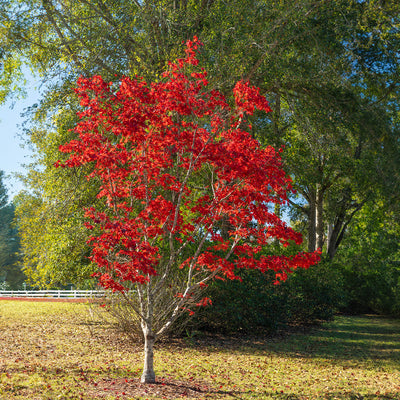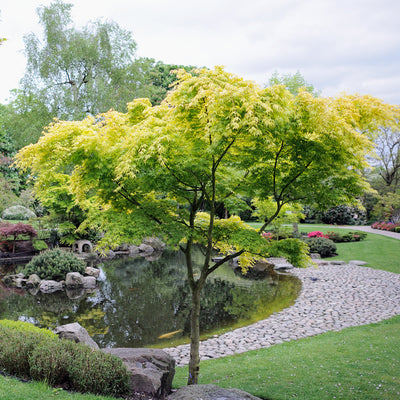Japanese Maple Trees for Sale Online
3 products
FREE Shipping on Orders Over $199
FREE Shipping on Orders Over $199
We’ve been growing landscape plants since 1980. We know it’s almost impossible to achieve a 100% survival rate. That’s why we’ve got you covered!
Our Perfect Plants 1 Year Warranty is roughly 10% of your plant total. It’s a cost-effective way to guarantee your plants for a full year.
If a plant dies up to 1 year after purchase, whether it's a weather related issue, human error, or anything else, just send us a picture at customerservice@myperfectplants.com and we’ll get you a store credit for the plant you purchased. The warranty does not cover the cost of shipping for any replacement.
Warranty must be purchased at the time of checkout and cannot be added after your order has been completed.
It’s that simple! Enjoy your new plants in confidence. Guarantee your plants for a full year today!
3 products
Japanese maples are highly prized for their graceful forms, their palmate foliage, and their beautiful colors. Native to Asia, these shade trees have been cultivated in other areas of the world for almost 200 years. They can be single or multi-stemmed.
Deciduous, their foliage ranges from light and airy to more traditionally palmate (hand-shaped) in shades from lime green through burgundy and purple.
Most Japanese maples are cultivars of Acer palmatum, but a few are derived from other species of Acer. They have been selectively bred for size, color, shape, and foliage. Japan maple trees are available to suit any size need and nearly any desired color.
Cultivars like our ‘Bloodgood’ are well known for their stunning fall colors, but Japanese maples provide four seasons of interest in the garden. Even through the winter, their graceful pattern of branches and flowing form breaks up the monotony of leafless bushes and conifers.
We have several new cultivars of Japanese Maple Trees available like the Orangeola Japanese Maple tree and Inaba Shidare Japanese Maple tree.
Using Japan maple trees in your landscaping is easy, with so many sizes and colors to choose from. Choose a large variety to serve as a stand-alone tree in a front yard or to draw the eye down from the roofline to the ground, softening the outline of the house.
Mid-sized Japanese maples are perfect for creating visual space, separating areas of your garden or yard, or providing backdrops for other features. Dwarf varieties can be planted directly into a perennial bed to provide color and texture.
Japanese maples are often used in Asian-inspired gardening, and formal or semi-formal Japanese gardens practically require at least one of these zen-inspiring trees. Water features and Japanese maples go hand in hand, and water is often a feature in many Asian-themed gardens.
Plant Japanese maples like other small trees and shrubs. Begin by digging a hole as deep as the root ball but several feet wide.
Sunny or partially sunny spots work best. A place with good morning sun and dappled shade in the afternoon is ideal. The site should have good drainage. Mulch around the base to keep the soil cool and provide additional organic matter as the mulch breaks down.
Japanese maple trees take root best in the fall. When spring turns to autumn, try to find an area that suits your tree based on sunlight and soil. It's best to plant Japanese maple trees about a month before the ground freezes for the winter. This will allow the roots to take hold for the season. Come spring, your Japanese maple tree will be settled in for the growing season.
Japanese Maple Trees are vulnerable to burning if they are in hot locations with full sun. That’s why the prefered planting location is in dappled shade. Areas with dappled shade have a mix of sun and shade, often due to surrounding trees or structures.
Most Japanese maples are hardy to USDA zone 5 and do well up to zone 8. Some cultivars are available, which may survive in sheltered sites with colder winters. Small Japanese maples can do quite well in large containers for those living in frostier locations. Bring them in once they go dormant in autumn, and let them overwinter in a garage or basement.
Mature heights and spread for Japanese maple trees can vary widely by cultivar. Our weeping Japanese maple reaches 6-10 feet high at maturity and spreads to 10 or 12 feet. Larger varieties can reach 20 feet in height and width. Dwarf Japanese maples may be only 3-4 feet tall but spread like an umbrella.
Like many other species of Acer, Japanese maples prefer soil that is well-drained and somewhat high in organic matter. Think of the typical humus-rich soils in an established forest.
They may need watering if planted in hot, sunny locations but typically are low-maintenance. They should not need supplemental fertilizer.
Japanese maples do not need much pruning. Crossing branches, winter damage, and vertical suckers can be removed. If pruning is necessary, do so in summer after the growth flush. You will be able to easily see any errant branches or other issues to take care of.
Buy Japanese maple tree for sale from Perfect Plants today.
Subscribe Today & Save On Your First Order!








